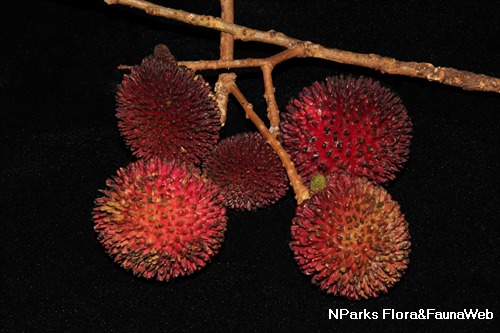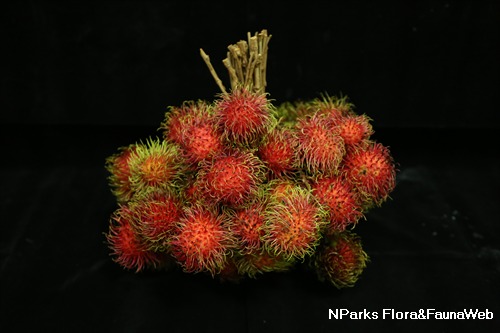_lowres.jpg)
Back
Nephelium juglandifolium Blume
| Family Name: | Sapindaceae |
Nephelium juglandifolium is a tree, up to 30 m tall. Found in the rainforests, it has long white inflorescence. The fruit ripens red, and is often densely covered with coarse warts. The seed is surrounded with an edible white fleshy sarcostesta.
Name
Classifications and Characteristics
| Plant Division | Angiosperms (Flowering Seed Plants) |
|---|---|
| Plant Growth Form | Tree |
| Lifespan (in Singapore) | Perennial |
| Mode of Nutrition | Autotrophic |
| Maximum Height | 30 m |
Biogeography
| Native Distribution | Peninsular Malaysia, Sumatra and Java. |
|---|---|
| Native Habitat | Terrestrial |
| Preferred Climate Zone | Tropical |
| Local Conservation Status | Non-native |
Description and Ethnobotany
| Growth Form | It is a tree which can reach up to 30 m tall and the trunk can reach up to 0.9 m diameter. |
|---|---|
| Foliage | Leaves are compound, paripinnate and spirally arranged. The leaf stalk (petiole) is 6 – 14 cm long. Each leaf comprises of (1) 3 – 7 leaflets. They are narrowly elliptic to ovate (7.5 – 32 cm long and 2.5 – 9.5 cm wide) and thinly leathery. The leaflet base is rounded or wedge shaped (cuneate) while leaflet tip is obtuse to rounded, sometimes shortly tapering (acuminate). The upper surface of the leaflet is glabrous while the underside can be glabrous or covered sparsely with short hairs. The domatia are rarely present. |
| Flowers | Inflorescence occur as a long spike (thyrsoid) at the pseudoterminal position. The inflorescence comprises of many small greenish white flowers. The flowers are unisexual, and likely dioecious (sometimes monoecious). Male flower has 7 to 8 stamens each. |
| Fruit | The fruit is mostly ellipsoid (3.5 – 5 cm long and 2.5 cm wide) and densely covered with coarse warts which can reach up to 4 mm high. It is fleshy and turns red when ripe. The seed is surrounded with a thick and white fleshy sarcostesta. |
| Habitat | It is found in rainforest, up to 650 m altitudes. |
| Associated Fauna | Flowers are pollinated by insects. The fruit are eaten mainly by primates and squirrels, and likely dispersed by primates. |
| Etymology | Genus epithet 'Nephelium', in Greek, means a little cloud, which refers to the fruit. Latin juglandifolium, refers to the leaves that bear a resemblance to those of the walnuts. |
| Ethnobotanical Uses | Edible Plant Parts : Edible Fruits Food (Fruit or Vegetable): The white fleshy sarcotesta of the fruit is edible and reported to have a sourish taste. |
Landscaping Features
| Landscape Uses | Parks & Gardens, General |
|---|
Fauna, Pollination and Dispersal
| Pollination Method(s) | Biotic (Fauna) |
|---|---|
| Seed or Spore Dispersal | Biotic (Fauna) |
Plant Care and Propagation
| Light Preference | Full Sun |
|---|---|
| Water Preference | Moderate Water |
| Plant Growth Rate | Moderate |
Foliar
| Foliage Retention | Evergreen |
|---|---|
| Mature Foliage Colour(s) | Green |
| Foliar Type | Compound |
| Foliar Attachment to Stem | Petiolate |
| Foliar Apex - Tip | Acuminate, Obtuse, Rounded |
| Foliar Base | Cuneate, Rounded / Obtuse |
Non - Foliar and Storage
| Trunk Type (Non Palm) | Woody |
|---|---|
| Root Type | Underground |
Floral (Angiosperm)
| Flower & Plant Sexuality | Unisexual Flowers |
| Flower Colour(s) | Green, White |
|---|---|
| Flower Grouping | Cluster / Inflorescence |
| Flower Symmetry | Radial |
| Inflorescence Type | Thyrse |
Fruit, Seed and Spore
| Mature Fruit Colour(s) | Red |
|---|---|
| Mature Fruit Texture(s) | Bumpy / Tuberculate |
| Seed Quantity Per Fruit | Few (1-5) |
References
| References | Adema, F., Leenhouts, P.W. & van Welzen, P.C. (1994). Sapindaceae. In: Kalkman, C. et al (eds) Flora Malesiana, ser. 1, vol. 11 (3), pp. 419–768. Leiden: Rijksherbarium/Hortus Botanicus, Leiden University van Welzen, P.C. (2017). Sapindaceae. In: Kiew, R. et al (eds) Flora of Peninsular Malaysia Series II: Seed Plants vol. 6, pp. 63–191. Kuala Lumpur: Forest Research Institute Malaysia |
|---|
Image Repository
Others
| Master ID | 30173 |
|---|---|
| Species ID | 4482 |
| Flora Disclaimer | The information in this website has been compiled from reliable sources, such as reference works on medicinal plants. It is not a substitute for medical advice or treatment and NParks does not purport to provide any medical advice. Readers should always consult his/her physician before using or consuming a plant for medicinal purposes. |

_lowres.jpg)
_lowres.jpg)
_lowres.jpg)
.jpg)


_lowres.jpg)